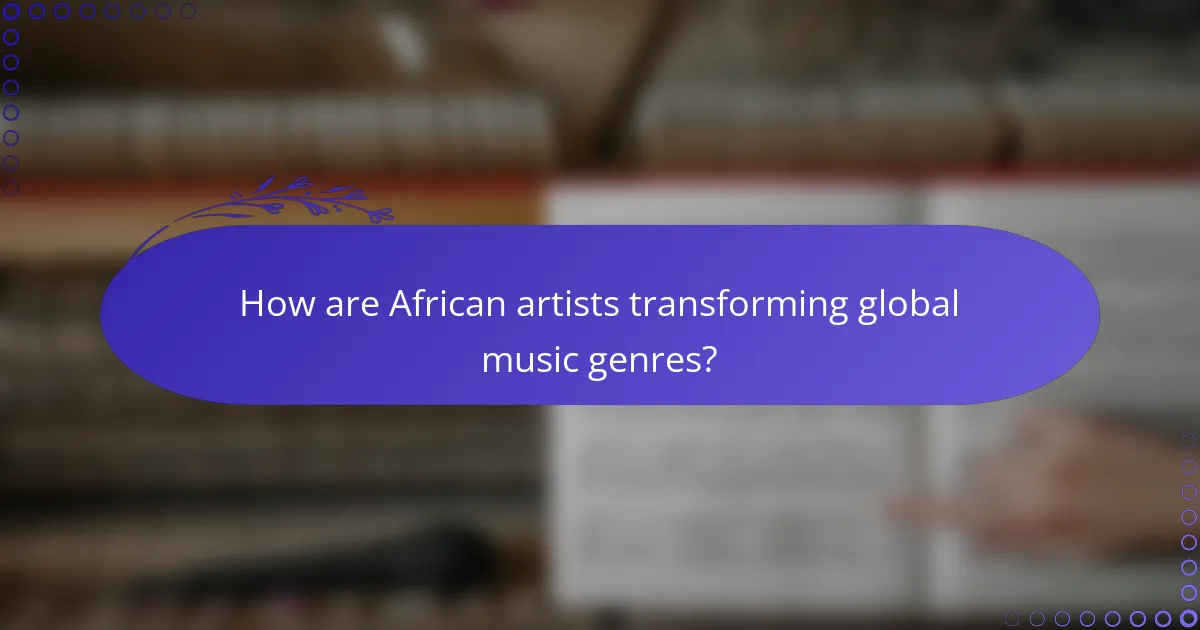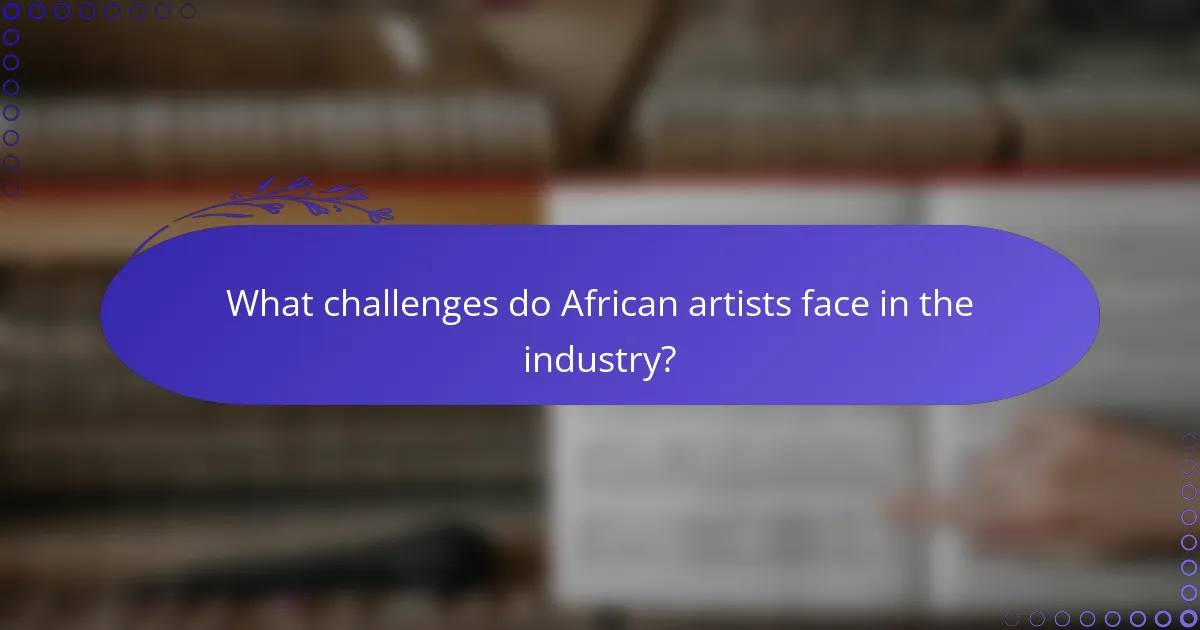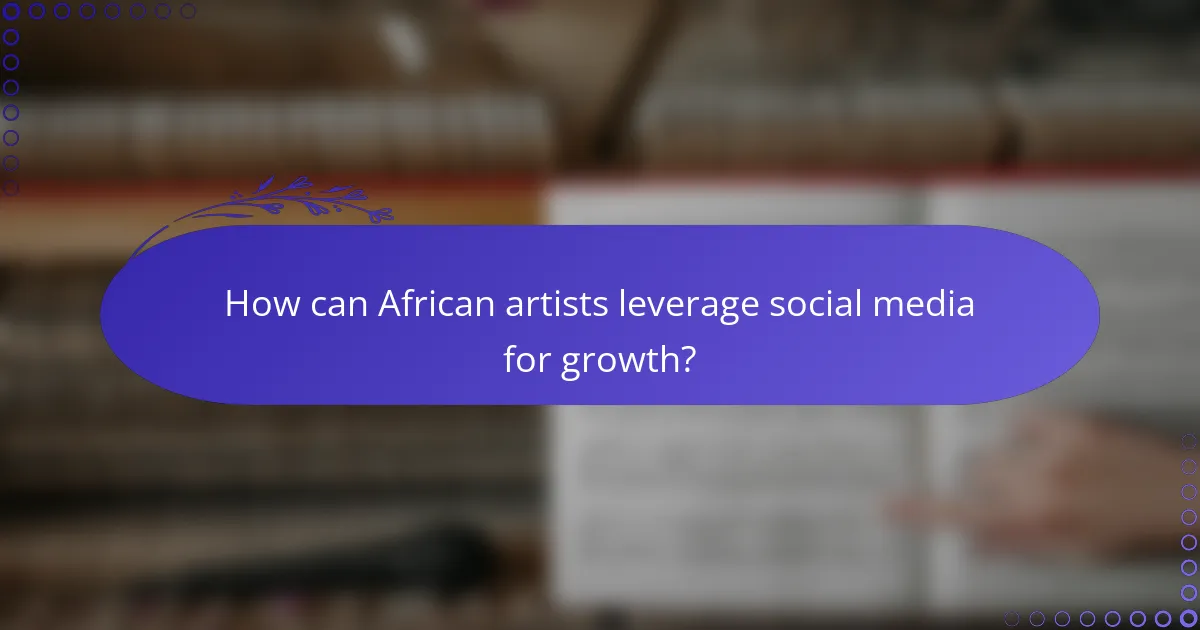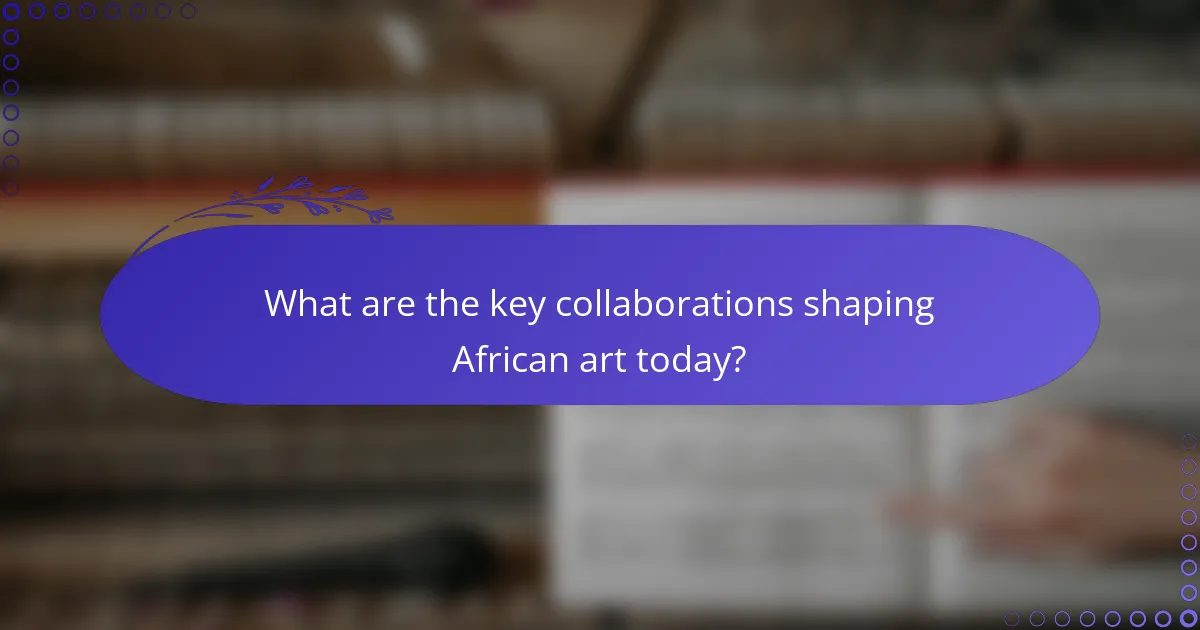African artists are at the forefront of a transformative movement in music and visual arts, blending traditional elements with modern influences to create groundbreaking styles. Their innovative contributions not only redefine musical genres but also enrich cultural identity, fostering pride and understanding of diverse African heritages. By leveraging new technologies and platforms, these artists are expanding their global reach and reshaping the landscape of contemporary art.

How are African artists transforming global music genres?
African artists are reshaping global music genres by infusing traditional sounds with contemporary influences, creating unique styles that resonate worldwide. Their innovative approaches not only elevate African music but also challenge and redefine existing musical boundaries.
Afrobeats influence on pop music
Afrobeats has significantly impacted global pop music by introducing infectious rhythms and vibrant melodies. Artists like Burna Boy and Wizkid have collaborated with international stars, blending Afrobeats with pop elements, which has led to chart-topping hits and increased visibility for African music.
This genre’s appeal lies in its danceable beats and catchy hooks, making it a favorite in clubs and on streaming platforms. The fusion of Afrobeats with pop has resulted in a fresh sound that attracts diverse audiences, enhancing its global reach.
Hip-hop evolution in Africa
African hip-hop has evolved into a powerful voice for social change and cultural expression. Artists across the continent, such as Nasty C and Sarkodie, incorporate local languages and themes into their lyrics, making the genre relatable to their audiences while also appealing to global listeners.
This evolution reflects a blend of traditional African storytelling and contemporary issues, allowing hip-hop to serve as a platform for discussing politics, identity, and social justice. Collaborations with international artists further amplify this genre’s influence, showcasing Africa’s rich musical diversity.
Fusion of traditional and contemporary styles
The fusion of traditional and contemporary styles is a hallmark of many African artists, who draw on their cultural heritage while embracing modern influences. Genres like Gqom and Amapiano exemplify this blend, combining traditional rhythms with electronic music elements to create innovative sounds.
This approach not only preserves cultural identities but also attracts younger generations, ensuring that traditional music remains relevant. By experimenting with different genres and styles, African artists continue to push creative boundaries, enriching the global music landscape.

What is the impact of African artists on cultural identity?
African artists significantly shape cultural identity by expressing diverse experiences and histories through their work. Their contributions foster a deeper understanding of African heritage and promote a sense of pride among communities.
Representation in global media
African artists are increasingly gaining visibility in global media, which enhances the representation of African cultures. This visibility helps challenge stereotypes and provides a platform for authentic narratives that reflect the continent’s rich diversity.
For instance, artists like Burna Boy and Angelique Kidjo have successfully crossed over into mainstream music, bringing African sounds to international audiences. Such representation not only influences global perceptions but also inspires local artists to innovate within their genres.
Promotion of African languages
Many African artists actively promote local languages through their music, literature, and visual arts. By incorporating indigenous languages into their work, they help preserve these languages and encourage their use among younger generations.
For example, artists like Wizkid and Youssou N’Dour often blend English with Yoruba and Wolof, respectively, making their music accessible while celebrating linguistic heritage. This practice not only enriches the cultural landscape but also fosters a sense of belonging and identity among speakers of these languages.

How are African artists innovating in visual arts?
African artists are innovating in visual arts by embracing new technologies and platforms that enhance their visibility and creativity. This innovation is reshaping traditional practices and expanding the global reach of their work.
Use of digital platforms for exposure
Digital platforms have become essential for African artists to showcase their work to a broader audience. Social media channels like Instagram and Facebook allow artists to share their creations instantly, reaching potential buyers and art enthusiasts worldwide.
Online galleries and marketplaces, such as Saatchi Art and Artsy, provide artists with opportunities to sell their work directly to collectors. This shift reduces reliance on traditional galleries, which can be limited in scope and accessibility.
Integration of technology in art creation
Many African artists are incorporating technology into their creative processes, using tools like digital painting software and 3D printing. This integration allows for experimentation with new forms and styles, pushing the boundaries of traditional art.
For instance, artists may use augmented reality to create interactive installations, engaging viewers in unique ways. This blend of art and technology not only enhances the artistic experience but also attracts a younger, tech-savvy audience.

What challenges do African artists face in the industry?
African artists encounter numerous challenges in the industry, primarily stemming from limited funding, inadequate resources, and restricted access to international markets. These obstacles hinder their ability to innovate and reach broader audiences, impacting their overall success.
Lack of funding and resources
Many African artists struggle with insufficient financial backing, which limits their ability to create and promote their work. Funding opportunities are often scarce, with grants and sponsorships being highly competitive and not widely available.
Additionally, resources such as quality materials, studio space, and professional training are often lacking. Artists may need to rely on personal savings or small local investments, which can stifle creativity and growth.
Access to international markets
Accessing international markets poses a significant challenge for African artists, as they often face barriers such as high shipping costs, complex regulations, and limited distribution networks. This makes it difficult for them to showcase their work globally.
Moreover, cultural differences and varying market preferences can complicate the acceptance of African art abroad. Artists may need to adapt their styles or marketing strategies to appeal to foreign audiences, which can dilute their authentic expression.

How can African artists leverage social media for growth?
African artists can effectively leverage social media for growth by creating engaging content that showcases their unique talents and cultural narratives. By utilizing platforms like Instagram, TikTok, and Twitter, they can reach broader audiences and build meaningful connections with fans worldwide.
Building a personal brand
To build a personal brand, African artists should focus on consistency in their messaging and visual identity across social media platforms. This includes using a recognizable logo, color scheme, and tone that reflects their artistic style and cultural background.
Engaging storytelling is crucial; artists can share their journey, inspirations, and creative processes through posts, videos, and live sessions. Regularly interacting with followers and responding to comments fosters a sense of community and loyalty.
Engaging with global audiences
Engaging with global audiences requires understanding cultural nuances and trends in different regions. Artists should tailor their content to resonate with diverse viewers while maintaining authenticity to their roots.
Utilizing hashtags relevant to both local and international audiences can increase visibility. Collaborating with other artists or influencers from various backgrounds can also enhance reach and introduce their work to new fan bases.

What are the key collaborations shaping African art today?
Key collaborations shaping African art today include partnerships between local artists and international musicians, as well as cross-genre collaborations that blend diverse musical styles. These collaborations not only enhance artistic expression but also broaden the reach and impact of African art on a global scale.
Partnerships with international musicians
Collaborations with international musicians have become a significant force in African art, allowing local artists to gain exposure and share their cultural narratives. For instance, partnerships with artists from Europe or North America often lead to unique fusions of sound, attracting wider audiences and increasing the commercial viability of African music.
These partnerships can take various forms, from joint albums to live performances. Artists like Burna Boy and Wizkid have successfully collaborated with global stars such as Ed Sheeran and Drake, resulting in chart-topping hits that showcase African rhythms and themes.
Cross-genre collaborations
Cross-genre collaborations are transforming the landscape of African art by merging traditional styles with contemporary genres like hip-hop, jazz, and electronic music. This blending creates innovative sounds that resonate with both local and international audiences, pushing the boundaries of artistic expression.
For example, artists like Sho Madjozi combine traditional Tsonga music with hip-hop elements, resulting in a fresh sound that appeals to younger generations. Such collaborations not only enhance creativity but also foster cultural exchange, enriching the global music scene.

What role do festivals play in promoting African artists?
Festivals play a crucial role in promoting African artists by providing a platform for exposure and engagement with diverse audiences. They celebrate cultural heritage while fostering creativity and innovation within the arts community.
Showcasing diverse talents
Festivals serve as a vibrant showcase for a wide array of artistic talents, including music, dance, visual arts, and theater. By featuring both established and emerging artists, these events highlight the rich cultural tapestry of Africa, allowing audiences to experience various genres and styles.
For example, events like the Cape Town International Jazz Festival and the Harare International Festival of the Arts attract artists from different backgrounds, creating a melting pot of creativity. This exposure can lead to greater recognition and opportunities for artists to expand their reach beyond local audiences.
Networking opportunities for artists
Festivals provide invaluable networking opportunities for artists, allowing them to connect with industry professionals, fellow creatives, and potential collaborators. These interactions can lead to partnerships, mentorships, and even funding opportunities that may not be available otherwise.
Additionally, many festivals host workshops and panel discussions that facilitate knowledge sharing and skill development. Artists can learn from experienced peers and industry experts, enhancing their craft and increasing their visibility in the competitive arts landscape.
